Entomopathogenic Nematodes : Natural solution for pests
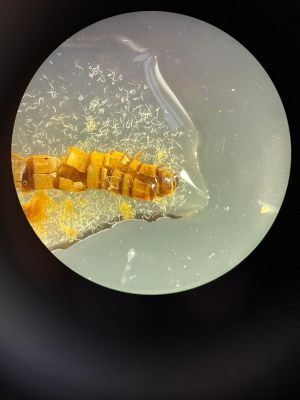
Beneath the soil lies a powerful ally for farmers: Entomopathogenic nematodes (EPNs). These microscopic parasites naturally target and destroy harmful pests, offering a sustainable, effective, and eco-friendly alternative to chemical pesticides. This article dives into the science, benefits, and practical applications of EPNs, empowering farmers with the knowledge to use these biological pest controllers to protect their crops and boost yields.
Description
What are EPNs ?
- Entomopathogenic Nematodes (EPN) are microscopic, parasitic worms that target and kill insect pests, acting as natural biological control agents. They primarily attack insect larvae in soil and hidden environments such as bark and root galleries.
How do EPNs work ?
- EPNs infect pests by entering their bodies through natural openings such as the mouth, spiracles, or anus. Once inside, they release symbiotic bacteria (Xenorhabdus or Photorhabdus), which multiply rapidly and produce toxins that kill the host within 24-48 hours. The nematodes feed on the host’s liquefied tissues, reproduce, and generate new infective juveniles (IJs) that emerge to seek new hosts, continuing the cycle. This efficient mechanism ensures rapid pest mortality while being safe for non-target organisms and the environment.
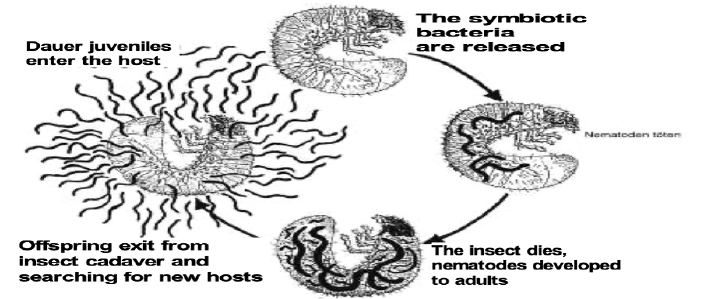
Why EPNs ?
Advantages
For Farmers:
- Reduce chemical pesticide use, lowering costs and residues on crops.
- Enhance crop health and yields by effectively controlling soil-dwelling pests.
- Provide long-term pest control when used as part of integrated pest management (IPM).
For the Environment:
- Protect beneficial insects such as pollinators and predators, promoting ecological balance.
- Reduce soil and water contamination caused by chemical pesticides.
- Support biodiversity by targeting only specific pest species (also harmless for humans and pets).
- Improve overall soil health by maintaining natural soil organisms.
How to use it ?
- Soil Drenching: Suitable for general field applications.
- Dipping: Suitable for special cases like for strawberries.
- Spraying: For turf and foliage applications, using appropriate nozzles to ensure EPN survival.
- Drip Irrigation: Can be used with modifications to ensure even distribution.
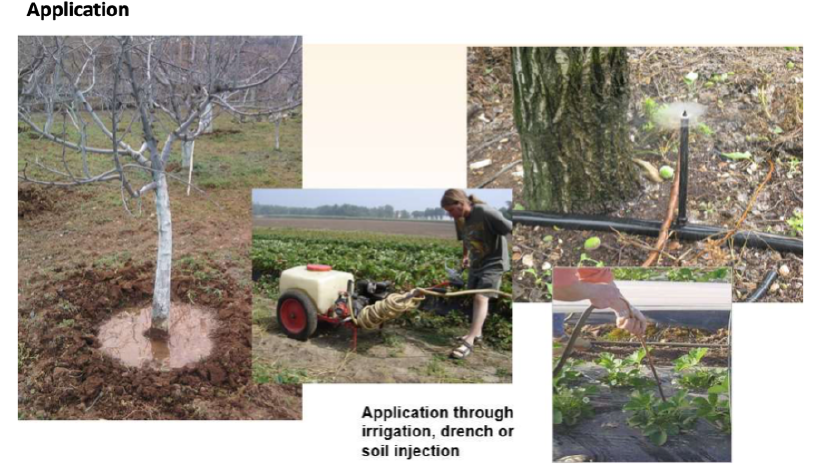
Various techniques for applying EPNs
- Mixing and Applying: Mix with water, apply using a sprayer or irrigation system. Apply early morning or evening when soil is moist and temperatures are cooler (refer to specific product website page for application guidelines and illustrations).
- Frequency: Typically applied 2-3 times per year depending on pest pressure, crop type, and environmental conditions (refer to table and the remark).
- Crop Categories: Root vegetables (e.g., potatoes, carrots), berries (e.g., strawberries, raspberries), leafy vegetables (e.g., cabbage), ornamentals, fruits and nuts trees, etc.
- Pests: Effective against pests with significant soil interface exposure, such as white grubs, root weevils, and fungus gnats.
- Winter Survival: EPNs can survive winter in soil under natural conditions, but populations decline significantly. Farmers may need to reapply annually for effective pest control.
- Examples for timing for application (see product website page for more)-
· Mole crickets: April to September.
· Cutworms: June to August.
· Meadow crane flies: September to mid-October (soil temperature at least 12°C)
Soil and Environmental Conditions:
- Optimal temperature range: 5-35°C depending on the species.
- Maintain high soil moisture (minimum 98% relative humidity) for effective nematode movement and pest invasion.
- EPNs are sensitive to UV light; applications are best performed in the evening or under cloudy conditions.
Handling and Storage:
- Store EPNs between 4°C and 10°C.
- Avoid freezing or overheating; temperatures above 38°C are fatal to EPNs.
- Ensure proper agitation of the solution during application to maintain oxygen levels.
Quality Control:
- Counting Live Nematodes: Ensure only live, active EPNs are used for application.
- Infectivity Tests: Regular tests to confirm the efficacy of EPN batches.
The cost:
- The cost of EPNs varies depending on the product, species, dosage, and application method. Generally, it ranges from €90 to €160 per hectare for standard applications. These costs typically align with the information provided by manufacturers like BASF, Koppert, e-Nema and ARBICO Organics. Farmers are encouraged to visit these companies' websites to explore a wider range of products, calculate specific costs, and determine appropriate dosages and application criteria tailored to their needs.
Knowing more : Typical Species of EPNs:
- Heterorhabditis bacteriophora: Known for its effectiveness against black vine weevil larvae in crops like strawberries and rhododendrons.
- Steinernema feltiae: Commonly used for controlling sciarid flies in greenhouses and other soil-dwelling pests.
- Steinernema carpocapsae: Targets red palm weevil and diamondback moth in cabbage.
- Steinernema kraussei: Suitable for black vine weevil control in colder climates.
Reality check : Examples of EPN Application
- Heterorhabditis bacteriophora, Steinernema carpocapsae, and Steinernema feltiae are effective against all larval stages (L1 to L4) of Tuta absoluta(tomato leaf minor). EPNs can be applied via soil drenching or foliar spraying, targeting larvae in leaf tunnels and soil. Trials show over 60-85% larval mortality within 72 hours when EPNs are used during peak infestation periods. This eco-friendly approach reduces reliance on chemicals and provides rapid pest control for tomato crops.
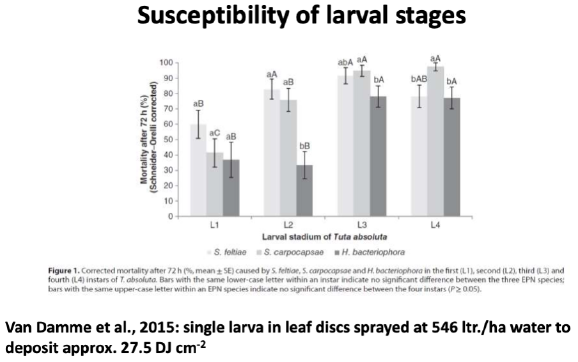
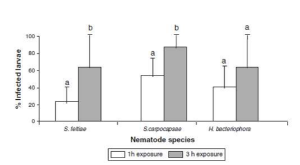
- Heterorhabditis bacteriophora is in controlling black vine weevil larvae in strawberry fields. This pest, which causes significant root damage, can be effectively managed by applying EPN during the larvae's active periods (April-May and August-September). Application can be through soil drenching or dipping the roots of plants before planting. Studies show a high efficacy rate, with mortality of vine weevil larvae reaching significant levels, providing a sustainable and effective pest management solution(product Nematop for e-nema).
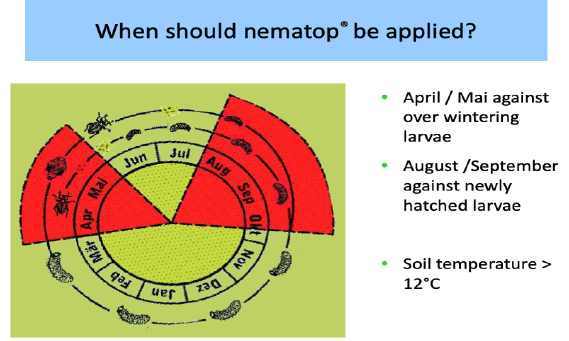
Example of a product usage guidelines
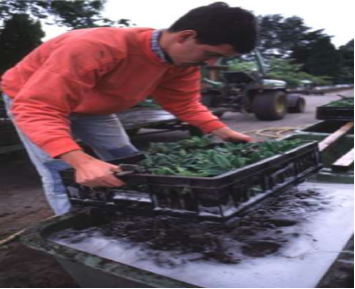
General guiding table for farmers:
Remark - The table provided showcases a few examples of EPN products, pests, and crops where these biological agents are effectively used. It is not a comprehensive list, as EPNs can be applied to many more pests and crops than mentioned here. Farmers can explore similar products for other nematode species, additional pests, and varied crops by referring to company websites like BASF, Koppert, and e-Nema, where detailed options are available. This broader market data enables farmers to make informed choices and calculate specific requirements for their fields.
| Crop | Pest | EPN
species |
Commercial
Product |
Company | Dosage
(per ha) |
T° | Moisture | Applicatio ns per year | Cost (€/ha) |
| Potatoes, Turfs | White
grubs |
Heterorhabditis
bacteriophora |
Nemaseek | ARBICO
Organics |
2.5 billion nematodes | 15-30°C | Moist soil (not waterlogged) | 2 (sping & summer) | 130-150 |
| HB Plus | e-Nema
GmbH |
2-3billion nematodes | 18-28°C | Moist conditions | 2-3 cycles | 130-150 | |||
| Carrots | Root
weevils |
Steinernema
kraussei |
NemAttack | ARBICO
Organics |
1 billion nematodes | 14-32°C | High moisture | 2 (early infestation period) | 100-120 |
| Strawberries | Black
vine weevil |
Steinernema
feltiae |
Kraussei | BASF | 1-2 billion nematodes | 10-30°C | Continuous moisture | 2-3 during infestations | 150-180 |
| Tomatoes | Fungus
gnats, Tuta absoluta |
Steinernema
feltiae |
NemAttack | ARBICO
Organics |
1 billion nematodes | 14-25°C | Consistent soil moisture | 2-3 (during pest life cycle) | 100 |
| Cabbage | Cabbage maggot, Diamond black moth | Heterorhabditis
bacteriophora |
NemAttack | ARBICO
Organics |
1 billion nematodes | 10-30°C | High soil moisture | 1 (early spring) | 100-120 |
| Turf | Scarab larvae | GrubOut | e-Nema
GmbH |
2.5 billion nematodes | 18-28°C | Moist soil | 1 (spring) | 60-80 |
Limitations:
- For the Farmer: EPNs require precise application (timing and moisture) for optimal results, and the initial cost can be higher. While they can survive in soil for weeks to months, their population declines over time, necessitating annual reapplication to maintain pest control.
- For the Environment: EPNs depend on high soil moisture for survival and effectiveness, making them less suitable for areas with frequent droughts unless irrigation is used.
Things to keep in mind:
- Sedimentation in Systems: Regular checks and agitation during drip irrigation to prevent uneven distribution.
- Environmental Factors: Soil moisture and temperature are critical for EPN survival and efficacy.
- Product Variability: Differences in nematode size and formulation affect product weight and application rates.
- Equipment related: Always check for specific guidelines for spray nozzle dimensions and maintenance, etc.
Acknowledgment
We would like to extend our gratitude to Ghent University (IMaNema) and Professor Ralf Ehlers for their contributions to the understanding of EPNs and to e-Nema GmbH for their research and commercial products, which have advanced biological pest control practices. The data, techniques, and examples provided are drawn from their extensive work in this field. Special thanks to University Côte d’Azur (MSc BOOST) for providing us the platform for this work.
Product Websites:
- BASF BioSolutions for Beneficial Nematodes(https://www.basf.com)
- e-nema product page(https://www.e-nema.de)
- Koppert Product Page(https://www.koppert.com)
- ARBICO Organics(https://www.arbico-organics.com)
- Grow it depot(https://www.growitdepot.com)
- DSMZ (German Collection of Microorganisms and Cell Cultures)(https://www.dsmz.de)
What people say ?
- In a video discussing the use of EPNs, a professor from Cornell University shares his views. He highlighted the ease of application and the noticeable difference in pest management compared to chemical methods. Biological Control: Entomopathogenic Nematodes (EPNs)
References
- EPN studies from Ghent University, led by Professor Ralph Ehlers
- Kumar, D., Kumari, P., Kamboj, R. et al. Entomopathogenic nematodes as potential and effective biocontrol agents against cutworms, Agrotis spp.: present and future scenario. Egypt J Biol Pest Control 32, 42 (2022). https://doi.org/10.1186/s41938-022-00543-5
- Labaude, S.; Griffin, C.T. Transmission Success of Entomopathogenic Nematodes Used in Pest Control. Insects 2018, 9, 72. https://doi.org/10.3390/insects9020072
- Patrick Fallet, Didace Bazagwira, Livio Ruzzante, Geraldine Ingabire, Sacha Levivier, Carlos Bustos-Segura, Joelle Kajuga, Stefan Toepfer, Ted C J Turlings, Entomopathogenic nematodes as an effective and sustainable alternative to control the fall armyworm in Africa, PNAS Nexus, Volume 3, Issue 4, April 2024, pgae122, https://doi.org/10.1093/pnasnexus/pgae122
- Jacas Miret & Llácer Archelós, et al.Spraying EPN + Biorend before and after RPW infestation (2007)
- Book Nematodes as biocontrol agents -by Parwinder S. Grewal, Ralf-Udo Ehlers and David I. Shapiro-Ilan August 2004, published by CABI.
- OECD-COST Workshop Malente, Germany (1995) published in Biocontrol Science and Technology 6, 1996 (190 pp.)
- Barbercheck + Millar (2000): Environmental impacts of EPN used for biological control in soil. In: Follett and Duan: Non-target Effects of Biological Control. Kluwer Academic Publ.
- Akhurst + Smith (2002) Regulation + Safety of EPN. In. Gaugler: Entomopathogenic Nematology, CABI Bioscience